technological innovation
Mastering Key Techniques of Aluminum Alloy Welding in One Article
Aluminum alloy, as a rapidly emerging engineering metal material in recent years, has been widely used in aerospace, automotive, and shipbuilding industries due to its low density, high specific strength and stiffness, and good corrosion resistance, among other advantages. However, the development of aluminum alloy structural components is constrained by issues such as poor weldability and unsatisfactory performance of the weld zone. Therefore, aluminum alloy welding technology has become one of the main research areas for many scholars both domestically and internationally.
1. Overview of aluminum alloy properties
①Aluminum is a very lightweight metal material with a density of only 2.7 g/cm3, which is about 36% of the density of steel. Using aluminum alloy to manufacture mechanical components can significantly reduce weight, achieving lightweight and energy-saving effects.
②Aluminum alloy has a higher specific strength and specific stiffness than 45 steel and ABS plastic. Using aluminum alloy materials is beneficial for manufacturing rigid components with high stiffness requirements.
③Aluminum alloy has excellent thermal conductivity, electrical conductivity, and corrosion resistance. A380 aluminum alloy's performance parameters compared to other materials are shown in Table 1.
④Aluminum alloy has good machinability and recyclability. Assuming the cutting resistance coefficient of the most easily machinable magnesium alloy is 1, the cutting resistance of other metals is shown in Table 2. It can be seen that aluminum alloy has lower cutting resistance than materials such as copper and iron, making it easier to machine.
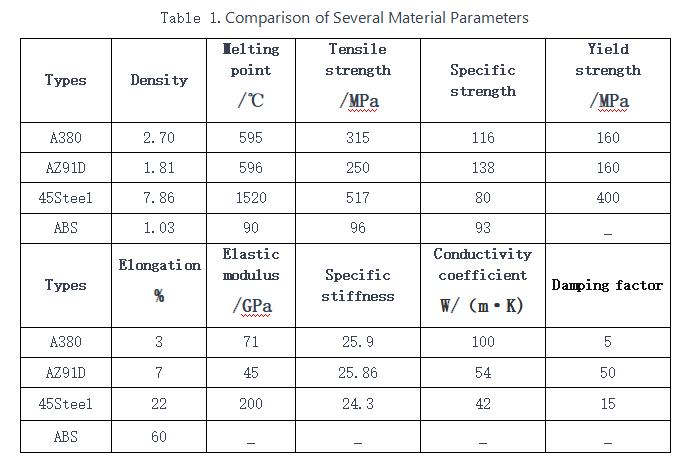
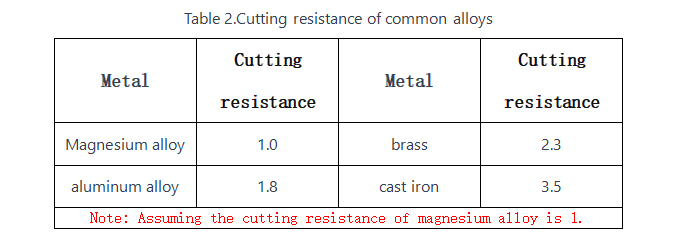
2.Characteristics of Aluminum Alloy Welding
Influence by the physical and chemical properties of aluminum alloys, there are certain difficulties in the welding process. Currently, aluminum alloy welding mainly faces several issues such as thermal stress, burn-off and evaporation, solid-state inclusions, and porosity collapse.
· Thermal stress
Aluminum alloys have a high coefficient of thermal expansion and a low elastic modulus. During the welding process, the aluminum alloy undergoes significant deformation and has a high linear expansion coefficient. The volume shrinkage rate during solidification is approximately 6%. Additionally, the cooling rate and the rate of primary crystallization in the weld pool are fast. These factors result in significant internal stress in the weld and high rigidity constraint of the welded joint. As a result, large internal stresses are generated in the aluminum alloy joint, leading to welding stress and deformation, as well as the formation of defects such as cracks and ripple deformations.
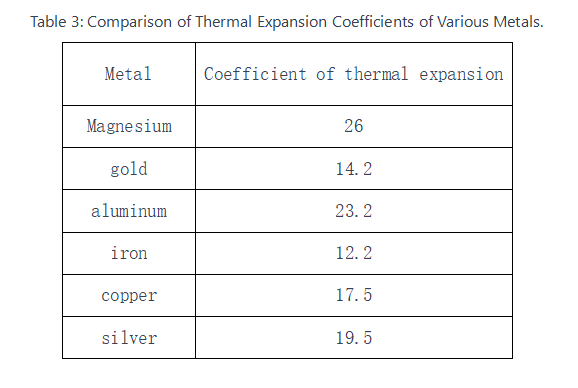
· Ablative evaporation
The melting point of aluminum is 660°C, and the boiling point is 2647°C, which is lower compared to other metals such as copper and iron. During the welding process, if the welding temperature is too high, it can lead to explosions and spatter, especially in high-energy beam welding, as shown in Figure 1. Additionally, some alloying elements added to aluminum alloys have lower boiling points, making them prone to evaporation and burn-off under the high transient temperature during welding. The spatter generated by explosions can also carry away some droplets, inevitably altering the predetermined chemical composition of the weld zone, which is unfavorable for controlling the performance of the welded joint. Therefore, to compensate for high-temperature burn-off, welding wires or other welding materials with higher boiling point element content than the base material are often selected for welding.
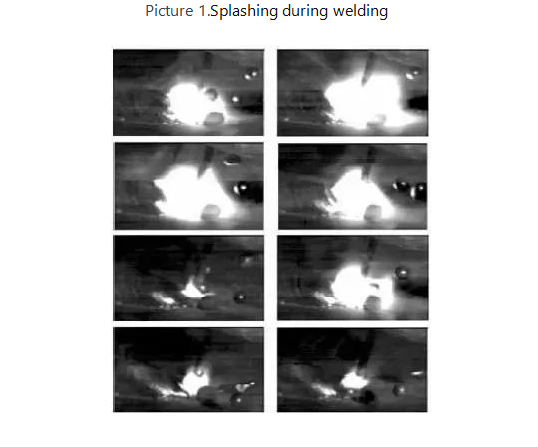
· Solid inclusion
Aluminum has a highly reactive chemical nature and is prone to oxidation. During the welding process, the aluminum alloy surface undergoes oxidation, forming a high-melting-point compound, Al2O3 (approximately 2050℃, while the melting point of aluminum is 660℃, resulting in a significant difference). The oxide is dense and has a high hardness. It tends to form small solid inclusions in the less dense molten alloy, making it difficult to remove them. This not only affects the formation of the weld's microstructure but also promotes electrochemical corrosion. This leads to a decrease in the mechanical properties of the welded joint. Additionally, the presence of Al2O3 covering the weld pool and groove significantly affects the welding of the alloy and reduces the structural performance of the welded joint.
· Stomatal collapse
The melting point of aluminum alloy is much lower than that of its oxide, and it is highly reactive and prone to oxidation. During the welding process, the aluminum alloy is melted to form a weld pool. The aluminum on the surface of the weld pool is oxidized, forming an oxide film that covers the molten pool in solid form. Since the color of the oxide film after melting is not significantly different from the molten state of the aluminum alloy, and the presence of the oxide film makes it difficult to observe the extent of aluminum alloy melting during the welding process, it is easy to cause excessive temperature, resulting in significant collapse in the heat-affected zone, thus damaging the shape and properties of the weld metal.
Under the instantaneous high-power heat input of the welding heat source, a large amount of hydrogen is dissolved in the molten alloy. After welding is completed, as the temperature of the weld pool decreases, the solubility of the gas also decreases gradually. This is the main reason for the formation of gas pores during the welding process. Due to the fast solidification rate and low density of aluminum alloy, different sizes of hydrogen pores are formed during the rapid solidification process of the weld. These pores continue to accumulate and expand during the welding process, ultimately forming visible macroscopic gas pores, which reduce the structural integrity of the joint. However, the formation of gas pores is not necessarily limited to the welding process, as the base material itself may have gas pores formed during the casting process. During welding, the thermal input and internal pressure continuously change, causing the original gas pores in the base material to expand or combine, forming weld porosity. As the welding heat input increases, the size of the gas pores also increases. Therefore, to control the source of hydrogen, the welding materials need to undergo strict drying treatment before use. During welding, increasing the current appropriately to prolong the existence time of the weld pool provides sufficient time for hydrogen to be released, thus controlling the formation of gas pores.
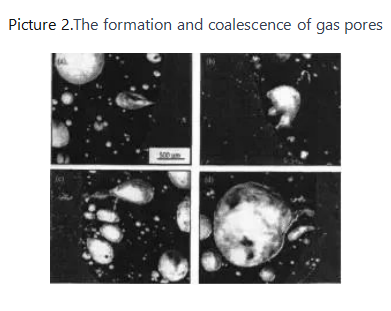
3.Classification of aluminum alloy welding techniques
With the expanding application range of aluminum alloys, there are also increasing challenges. As research progresses, there have been significant developments in aluminum alloy welding techniques. Currently, the main techniques include Tungsten Inert Gas (TIG) welding, Metal Inert Gas (MIG) welding, Laser Beam Welding (LBW), Friction Stir Welding (FSW), and so on.
· Tungsten Inert Gas (TIG) welding
Tungsten Inert Gas Welding (TIG) is a typical inert gas shielded welding method and is the most commonly used welding technique. During welding, a tungsten electrode and the welding area act as electrodes, and helium or argon gas is introduced between the electrodes as a shielding gas to protect the arc. The filler wire and base material are melted using high-voltage discharge, allowing for the welding and shaping of aluminum alloy components, as well as the repair and restoration of casting defects in castings.
TIG welding has the following technical features:
①Easy Operation: TIG welding is known for its convenience, flexibility, and controllability. It can adapt to various working conditions and is cost-effective.
②Narrow Heat-Affected Zone: TIG welding produces a narrow heat-affected zone. With sufficient wire feeding, it minimizes the deformation of the welded joint and enhances the overall performance of the joint.
③Excellent Welding Process Performance: TIG welding provides stable and reliable welding process performance. The resulting weld seam is dense, aesthetically pleasing, and exhibits good weld quality.
· Metal Inert Gas Welding(MIG)
MIG (GMA - Gas Metal Arc Welding) and TIG are both inert gas shielded welding methods, with the difference being that TIG welding uses a tungsten electrode as the fixed electrode, while MIG welding uses the filler wire material itself as the electrode.
In the process of MIG welding with aluminum alloy, the voltage and current are applied to the electrode end of the filler wire, creating a momentary high voltage between the filler wire and the base metal. This melts the base metal and the beveled edges, causing molten droplets to detach from the filler wire and transition onto the base metal pool, forming the welded area.
However, the application of MIG welding for aluminum alloy is limited due to several reasons. The softness of aluminum wire leads to poor wire feeding characteristics, and molten aluminum is prone to "dripping" without solidifying during welding, resulting in spatter. The advantage of MIG welding for aluminum lies in its faster welding speed compared to TIG welding. When welding large workpieces, the welding motion amplitude is small, and by adjusting the wire feeding speed, the welding efficiency can reach several meters per minute.
· Laser Beam Welding(LBW)
Laser Beam Welding (LBW) utilizes high-energy laser pulses to induce localized heating within a small area of the material. The energy from the laser radiation is absorbed by the material, causing rapid melting and the formation of a specific molten pool. After solidification, the materials are fused together.
The advantages of laser welding include a small welding heat-affected zone, concentrated high-power heat source, and the capability to weld thick plates with minimal distortion. However, laser welding requires precise positioning of the welding spot, expensive equipment, and higher welding costs. It is also challenging to directly weld metals with high laser reflectivity, such as aluminum-magnesium alloys.
When different power densities of laser are applied to the material, it is observed that when the power density on the workpiece exceeds 10^7 W/cm^2, the metal within the heating zone is rapidly vaporized, and the vapor condenses and gathers to form a small hole. Heat is transferred around this small hole, creating a molten pool near the hole, which is known as the "keyhole" effect in laser deep penetration welding. To avoid uneven melting caused by this phenomenon, the laser energy can be reduced, welding speed can be increased, or re-melting of the fusion zone can be controlled to remove bubbles and minimize the formation of pores.
· Friction Stir Welding(FSW)
Friction Stir Welding,FSW) is a novel solid-state joining technique that has evolved from traditional friction welding. It involves the use of a non-consumable tool with a special shape consisting of a stirring pin and a shoulder. The tool rotates and plunges into the interface between the materials to be welded. As the tool advances along the weld seam, the temperature of the welding material increases. The plasticized metal undergoes intense plastic deformation due to the mechanical stirring and forging action. After diffusion and recrystallization, a dense solid-state joint is formed.
Compared to traditional welding methods, Friction Stir Welding (FSW) technology has the following advantages:
①Lower welding temperature, resulting in reduced deformation during welding.
②Excellent mechanical properties of the weld joint.
③Simple, cost-effective, and environmentally friendly welding process.
4.The main existing problems and research emphases
As aluminum alloys are being increasingly used in various industries, the repair and joining issues of these alloys have attracted the attention of many researchers. Through various welding experiments using different welding techniques, it has been found that the maturity of repair technologies has not yet met the industrial development needs, and various problems still exist.
Tungsten inert gas (TIG) welding and gas metal arc welding (GMAW) are the two most widely used welding methods. However, these techniques have a wide heat-affected zone, and the weld metal needs to undergo the process of melting and solidification, which greatly affects the microstructure and leads to high residual stresses, thereby significantly impacting the mechanical properties of the joints. Laser welding, with its high beam density and larger weld depth-to-width ratio, is prone to the formation of pores, and its high cost limits its widespread application. Friction stir welding (FSW) provides a solution to the heat-related issues, but it requires relatively high forging pressure and forward driving force, and the equipment is generally complex and bulky, which limits its development.Therefore, the main problems and research focus in the repair and joining of aluminum alloys revolve around addressing the issues of heat input, residual stresses, porosity, and the complexity of the welding equipment. Researchers are striving to develop improved techniques and technologies to overcome these challenges and enhance the mechanical properties of the joints.
The research focus on relevant topics should be placed on the following aspects in the future:
①Starting from the fundamentals of fusion welding, adjustments can be made to the wire composition by incorporating rare earth elements or suitable welding fluxes. This helps control the deformation during welding, reduce stress, and minimize the generation of pores.
②Due to the expansion of alloy applications and their use in conjunction with dissimilar materials, it is necessary to conduct experiments on dissimilar metal welding to obtain high-quality joints for different combinations of materials.
③Research on composite heat source welding should be conducted, such as TIG-laser hybrid welding and laser-assisted friction stir welding. These approaches aim to achieve optimized weld seam properties by combining different heat sources and welding techniques.
RELATED NEWS
- Not sure about the T4, T5, and T6 materials of aluminum profiles? This article h 2024-03-20
- How to use aluminum profile section design skills to solve extrusion production 2024-03-19
- Factors affecting the life of trimming and punching molds 2024-03-12
- Overview of Steel/Aluminum Welding Technology 2024-02-29
- Steel belt conveying direction 2023-09-26
CATEGORIES
LATEST NEWS
CONTACT US
Contact: Manager:Miss Jasmien
Phone: +8618825429836
E-mail: info@gdaa-cn.com
Whatsapp:+8618825429836
Add: Headquarter:No.8,Yixian Road,GDAA Mansion,Guangfo Zhicheng, Dali Town,Foshan,Guangdong.China
